Ultrafiltration for egg processing
Ultrafiltration for egg processing
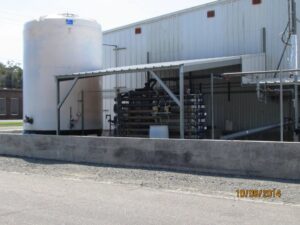 High protein content from the egg causes the BOD of wastewater from an egg processing plant to be high. The conventional approach is to treat the wastewater biologically, either aerobically or anaerobically. Both systems are expensive both to purchase and operate.
High protein content from the egg causes the BOD of wastewater from an egg processing plant to be high. The conventional approach is to treat the wastewater biologically, either aerobically or anaerobically. Both systems are expensive both to purchase and operate.
Solution
Tubular Ultrafiltration alone will reduce the BOD of the wastewater from an egg processing plant 94% on average. This simple filtration process mechanically separates the egg from the water and produces a concentrate of egg and water that can be processed by a renderer inexpensively.
97% of the filtered water purified by the Ultrafilter can be discharged to sewer.
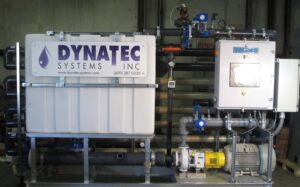
Benefits
- Lower capital cost compared to the alternatives
- Much lower operating costs compared to the alternatives
- Simple mechanical system
- Less space required
- Permeate acceptable for Municipal sewer discharge
- Low cost for disposal of residual egg concentrate
Contact Dynatec Systems today to discuss your wastewater solution
https://www.dynatecsystems.com/industries/food-and-beverage/egg-processing
Dynatec Systems industry-leading tubular ultrafiltration (UF) system is used to treat a broad range of industrial wastewater by separating insoluble components from waste streams. As a cost effective and simple solution for separating insoluble components and colloidal contaminants from a waste stream, wastewater UF offers significant advantages over conventional separation. It is a useful process that does not require chemicals or much space to separate insoluble contaminants.
UF is a pressure-driven process that removes the following from wastewater and other solutions:
- Emulsified oils
- Metal hydroxides
- Colloids
- Emulsions
- Dispersed material
- Suspended solids
- Other large molecular-weight materials
Ultrafiltration systems are also capable of concentrating:
- Bacteria
- Some proteins
- Some dyes
- Colloidal or emulsified components
Ultrafiltration systems excels at the clarification of solutions containing:
- Suspended solids
- Bacteria
- High concentrations of macromolecules including:
- Oil and water
- Fruit juice
- Milk
- Whey
- Electro-coat paints
- Pharmaceuticals
- Poly-vinyl alcohol and indigo
- Potable water
- Tertiary wastewater
Ultrafiltration offers the following advantages over conventional separation:
- No chemical required
- Very little labor required
- Simple mechanical process
- Less sludge
- Ability to concentrate the retentate for beneficial use
- Less space required
- Overall lower operating costs
Tubular Configuration:
- Higher permeate rate
- Lower rates of fouling
- Higher concentration of retentate
- Easier to clean
- Longer membrane life
- Low operating cost
For more information on using ultrafilter (UF) for your application, please contact us today.
MBR Leachate Treatment System
Prior to employing the Dynatec MBR leachate treatment system, the landfill was hauling all of their leachate. In 2010, the facility spent over $4,500,000 hauling 10,350 truckloads of raw leachate.
The landfill leachate was pumped from four different pump stations each with a different landfill contributory area. Analysis of the historical data showed the size of the contributory area and age of the landfill area played significant roles in flow and leachate quality. A few historical trends were identified and used to predict flows in a future landfill development scenario.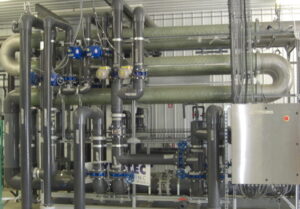
The MBR leachate treatment system was designed for the peak nitrification requirements of the influent. A large SRT (solids retention time) was selected to target the slowly biodegradable COD found in leachate due to long chain organic molecules that are more difficult to remove.
The system was designed with flexibility in mind. The MLSS can be increased to 20,000 mg/L in the system without affecting the oxygen transfer efficiency thanks to the jet aeration system selected, which enables the long SRT.
Dynatec’s industrial MBR is the ideal bioreactor configuration for treatment of organic or inorganic contaminants present in industrial wastewaters. MBR’s operate at a higher efficiency while achieving consistent design performance objectives. This makes MBR a more cost effective method of industrial wastewater treatment when performance and tank requirements are considered.
Industrial Membrane Bioreactors Benefits:
- Higher flux
- Lower costs
- Better membranes
- Improved permeate quality
- Less operator attention and maintenance
Contact Dynatec Systems today to discuss your landfill leachate treatment system.
https://www.dynatecsystems.com/industries/landfill-leachate-treatment/
A Clear Look at Reuse Systems
A Clear Look at Reuse Systems
Dynatec’s Tom Doherty had a great article published in the November 2021 issue of Water Environment & Technology (WE&T) Operations & Engineering magazine.
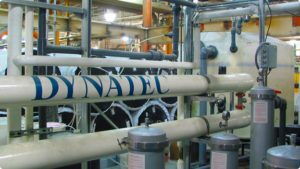
Dynatec has completed over a hundred wastewater purification and reuse systems for industry and for sanitary waste. To begin, there needs to be a detailed characterization of the wastewater along with a detailed characterization of the requirements for reuse. The characterization of the wastewater and requirements for reuse will determine the treatment/purification requirements and thereby define the CAPEX and OPEX. This estimate of costs should be completed early in the process to determine if the reuse project has merit and is cost-effective.
All of Dynatec’s treatment and reuse systems employ membrane filtration because the properly selected membranes provide the best method of insuring the qualitative result desired and in almost every case they provide the most cost effective method of achieving the desired result.
Membrane selection is based upon wastewater characteristics and the desired recovered water quality requirements in the process in which the membranes are utilized.
With the above information, treatability work is typically conducted to define the treatment system requirements and design parameters.
Typical wastewater treatment/purification systems for reuse are as follows.
- Purification of process baths/tanks for reuse typically using ultrafiltration
- Cleaning tanks with contaminants removed employing Ultrafiltration
- Scrubbers with contaminants removed employing Ultrafiltration
- Vibratory metal finishing with contaminants removed employing Ultrafiltration
- Any other employing UF and RO filtration to produce higher quality water for reuse
- Recovery of specific components found in the wastewater
- Precious metal recovery employing Ultrafiltration, Nanofiltration and/or Reverse Osmosis
- Latex paint recovery employing Ultrafiltration
- Textile size separation and recovery
- Others where removal of water allows concentration of the product to be recovered
- MBR biological treatment for reuse in cooling towers, scrubbers and like type water users that do not require potable water or high-purity water
- Food processing facilities where MBR permeate is used in cooling towers and scrubbers
- Metal working facilities where MBR permeate is used in cooling towers and scrubbers
- General manufacturing
- MBR biological treatment followed by Nanofiltration or Reverse Osmosis
- All types of manufacturing and food processing facilities where there is a requirement for higher purity water for reuse.
A Clear Look at Reuse Systems pdf
https://www.dynatecsystems.com/technologies/recovery-and-reuse/
Landfill Leachate Treatment System
A landfill which produces 200,000gpd of leachate needed a new treatment system to be able to discharge to surface water. Dynatec provided a Membrane Bioreactor (MBR) that utilized an existing tank as the bioreactor. A Reverse Osmosis (RO) system was also provided to further purify the MBR permeate prior to discharge. Repurposing existing assets saved the customer significant costs. The MBR conversion was the easiest and most cost-effective method to achieve their treatment goals.
Landfill leachate treatment systems with Membrane Bioreactors (MBR)s have developed many unique process improvements for industrial wastewater applications. Dynatec successfully uses Ultrafiltration (UF), MBR and Reverse Osmosis (RO) for landfill leachate applications.
Landfill leachate treatment system requirements
Treatment can vary, depending on the discharge requirements, and the contaminants present
Landfill leachate is characterized by: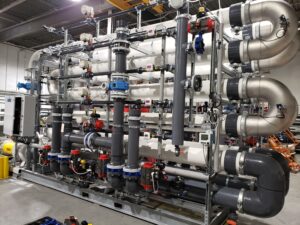
- High Total Dissolved Solids (TDS)
- Heavy metals
- High BOD
- Color
- High COD
- High ammonia
Landfill leachate treatment systems options
The MBR option: an aerated biological mixed liquor process operating at very high solids concentrations.
The advantages are:
- Long sludge age produces a well acclimated biomass. High concentration (typically 12,000 to 20,000 mg/l) provides very high rates of reaction
- Excellent nitrification and de-nitrification
- Smaller footprint then conventional aerated systems
- High-quality effluent as a result of using membranes for final clarification
- Lower sludge production than conventional systems
Alternative landfill leachate treatment options:
- Chemical precipitation of metals before MBR treatment
- RO after MBR treatment removes organic and inorganic contaminants, and color
- UF followed by RO
The two effluent streams from a RO system are:
- Permeate
- Concentrate (or reject)
This can be re-injected into the landfill. Its long-term effects on leachate concentrations should be considered.
Conclusion
The MBR process provides the highest possible levels of organic removal with essentially zero suspended solids in the effluent. This is the ideal feed system for RO treatment.
RO permeate can be used for other non-potable purposes:
For more information on landfill leachate treatment systems, please contact Dynatec.
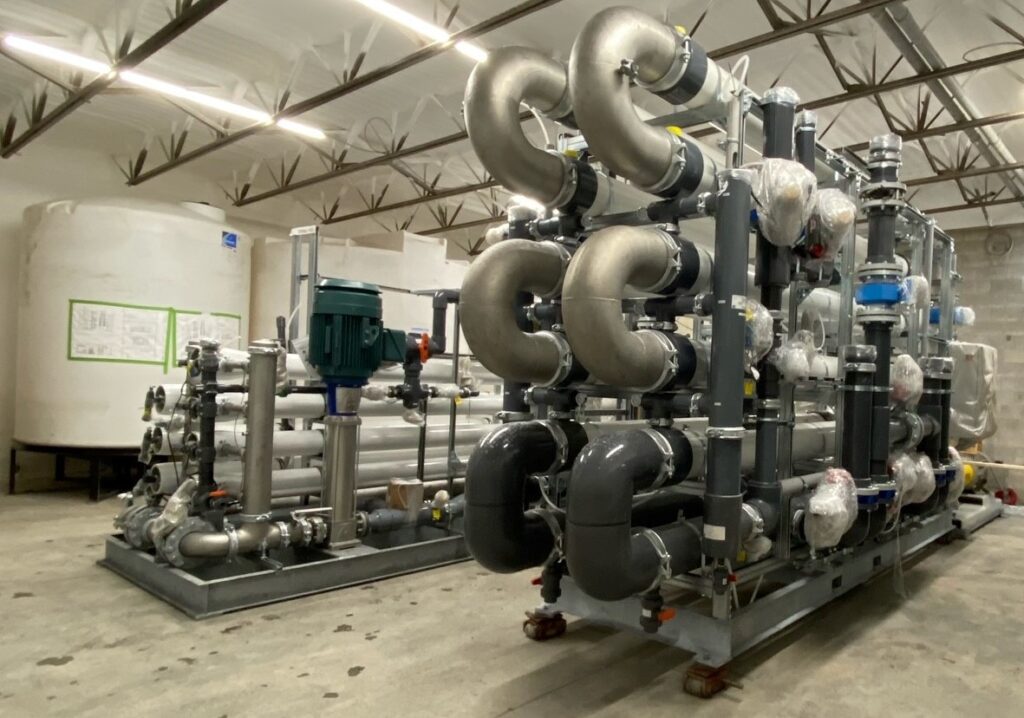
https://www.dynatecsystems.com/industries/landfill-leachate-treatment/
Ultrafiltration Removes Oil and Metals
Ultrafiltration removes oil and metals to allow the treated water to be acceptable for discharge for an automobile parts manufacturer. A UF system was selected based upon its ability to consistently meet the discharge requirements without chemicals and with limited operator involvement. This UF system removes oil and reduces zinc in compliance with discharge requirements.
Ultrafiltration excels at the clarification of solutions containing suspended solids, bacteria and high concentrations of macromolecules, including oil thus making this an excellent solution to this problem.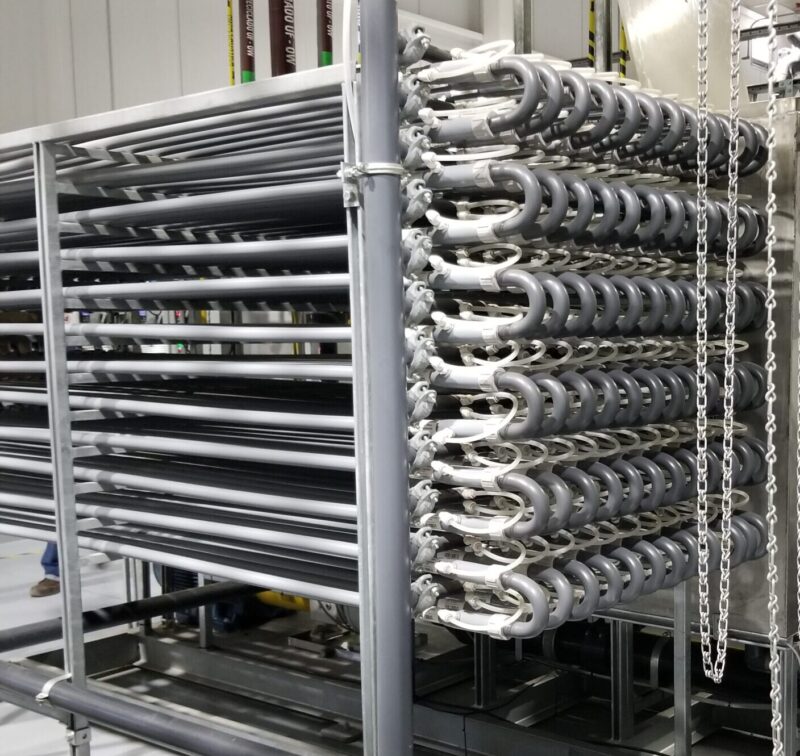
Ultrafiltration uses a membrane to separate suspended and colloidal materials in an aqueous phase. It will normally separate everything that is not soluble and some larger macro molecules that are soluble. Ultrafiltration uses a PVDF tubular membrane that is permeable to perform the separation. One of the uses that demonstrates the usefulness of ultrafiltration is separation of oil in an emulsion from water. In this case, machining coolant oil emulsions can have the oil separated and concentrated, with the water passing through the membrane, and the concentrated oil phase disposed.
Dynatec Systems industry-leading tubular ultrafiltration (UF) system is used to treat a broad range of industrial wastewater by separating insoluble components from waste streams. As a cost effective and simple solution for separating insoluble components and colloidal contaminants from a waste stream, wastewater UF offers significant advantages over conventional separation. It is a useful process that does not require chemicals or much space to separate insoluble contaminants.
UF is a pressure-driven process that removes the following from wastewater and other solutions:
- Emulsified oils
- Metal hydroxides
- Colloids
- Emulsions
- Dispersed material
- Suspended solids
- Other large molecular-weight materials
Ultrafiltration systems are also capable of concentrating:
- Bacteria
- Some proteins
- Some dyes
- Colloidal or emulsified components
Ultrafiltration systems excels at the clarification of solutions containing:
- Suspended solids
- Bacteria
- High concentrations of macromolecules including:
- Oil and water
- Fruit juice
- Milk
- Whey
- Electro-coat paints
- Pharmaceuticals
- Poly-vinyl alcohol and indigo
- Potable water
- Tertiary wastewater
Ultrafiltration offers the following advantages over conventional separation:
- No chemical required
- Very little labor required
- Simple mechanical process
- Less sludge
- Ability to concentrate the retentate for beneficial use
- Less space required
- Overall lower operating costs
Tubular Configuration:
- Higher permeate rate
- Lower rates of fouling
- Higher concentration of retentate
- Easier to clean
- Longer membrane life
- Low operating cost
For more information on ultrafiltration systems to remove oil and metals, please contact us today.
https://www.dynatecsystems.com/technologies/membrane-technologies/ultrafiltration-systems/
ZLD wastewater treatment system
ZLD wastewater treatment system for a food processing company was provided by Dynatec. The primary treatment is provided by a tubular membrane bioreactor (MBR) followed by reverse osmosis (RO). Membrane bioreactor permeate is reused for cooling tower make up. Reverse osmosis permeate is re-used for high-quality users and reverse osmosis (RO) reject is used for irrigation.
ZLD wastewater treatment system
Recovery and reuse systems have been provided by Dynatec Systems to many industries. The ability to recover and reuse water has many benefits.
- Saving on water costs
- Saving on wastewater disposal charges
- Decreased environmental impact
- Protection from regulatory changes
- Decrease dependence on water provider/source
- Ability to expand without affecting water demand
- Overcome water scarcity issues
- Consistently high-quality for water reuse
Ultrafiltration (UF), Membrane Bioreactor (MBR), Nanofiltration (NF) and Reverse Osmosis (RO) are employed by Dynatec for water reuse projects. Water recovery and water reuse has been successfully implemented with industrial and sanitary wastewater streams for: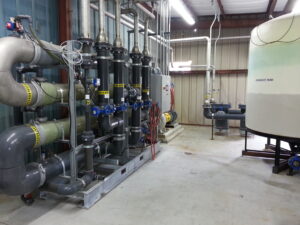
- Cooling tower make up
- Boiler feed
- Irrigation
- Toilet flushing
- Direct potable reuse
- Cleaning/wash applications
- Rinse processes
- Painting processes
- Other plant processes
Recovery and reuse systems provided by Dynatec Systems:
- Resorts, hotels, and retirement homes
- Golf courses
- Automotive companies
- Food and beverage companies
- Apartment buildings
- Landfills
- Mines
- Metal finishing plants
- Aerospace companies
Membrane Bioreactors
Membrane bioreactors offer a unique and effective solution for the treatment and reuse of industrial wastewater in industries such as landfills, automotive, aerostructures, distilleries and dairies. Our industry-leading designs and innovation also deliver superior performance for sanitary wastewater and biological nutrient removal applications.
The MBR configuration has proven to be optimal for treatment of many industrial wastewaters when treatment efficiency is an important consideration.
The MBR is the ideal bioreactor configuration for treatment of organic or inorganic contaminants present in industrial wastewaters. MBRs operate at a higher efficiency while achieving consistent design performance objectives. This makes MBR a more cost effective method of treatment when performance and tank requirements are considered.
Bioreactor systems such as the conventional activated sludge system, sequencing batch reactor system and trickling filters are typically designed for operation at a lower volumetric removal rate, requiring larger tanks and more space. These conventional systems often experience upsets that inhibit settling and therefore require much more operator attention than a membrane bioreactor.
The MBR has proven to be optimal for treatment of many industrial wastewaters because it is less susceptible to upsets. The MBR’s performance is not affected by changes in sludge settleability like the conventional systems, making MBR a wise choice for industrial systems that have more difficult to treat waste streams. Dynatec has over 42 years experience in dealing with difficult to treat industrial wastewaters using membrane filtration.
For more information on zero-liquid discharge (ZLD) wastewater treatment systems, please contact us today.
https://www.dynatecsystems.com/technologies/recovery-and-reuse/
PFAS Removal from wastewater
Per- and polyfluoroalkyl substances, or PFAS, is a group of thousands of synthetic chemicals that were used for decades in the manufacturing of many consumer goods like waterproof clothing, non-stick pans, stain resistant fabrics, food packaging, and in industries like paper and cardboard manufacturing, metal plating, wire manufacturing, plastic manufacturing, and many other applications.
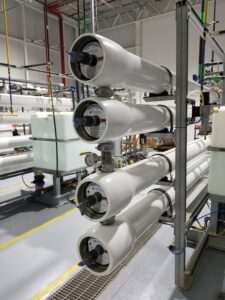
While providing desired characteristics to the many products in which they were used, PFAS chemicals have been tied to various negative health effects. Also of concern is the fact that they are very stable and break down very slowly in nature. PFAS chemicals are found in the environment and in the bloodstreams of people all over the world.
Dynatec has provided systems to remove PFAS from industrial wastewater to customers across the country and has dozens of systems in operation. While there are other technologies in various stages of development, there are two proven technologies for removing PFAS from industrial wastewater: carbon and reverse osmosis (RO). Dynatec has used both granular activated carbon (GAC) and RO for PFAS removal and we can help with the selection of treatment technology for a given application.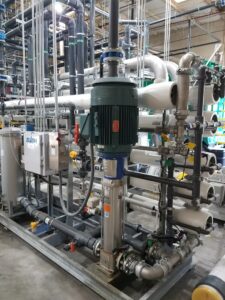
Landfills are a major accumulation location for PFAS as most of the PFAS laden products ultimately end up there. As the leader in landfill leachate treatment, Dynatec Systems has vast experience in treating complex, high strength wastewater and removing PFAS from these wastewater streams. With discharge limits shrinking across the country to single digit parts per trillion (ppt) for some of the most common PFAS compounds like PFOS and PFOA, most of our customers have non-detect levels of nearly all of the tested PFAS chemicals, even where the raw wastewater or leachate has individual PFAS compound concentrations of 3,000 to 5,000ppt or more.
We can design a system to meet any discharge requirement.
Please contact us today to discuss your PFAS removal needs.
MBR Discharge and Reuse
High quality discharge and reuse from MBR – Cereal Plant
Since the plant produces a food product, ultimate water quality was vital. The two-stage membrane system (MBR + RO) and final sterilization with ultraviolet (UV) treatment provided the quality assurance that plant management required. In addition, the membranes used in the MBR system are external to the aeration basin and are tubular. This type of membrane is much less susceptible to failure than the immersed type.
This process combines aerated biological treatment with an out-of-basin ultrafiltration (UF) system. In combination with reverse osmosis treatment, Dynatec was able to provide the client with the necessary assurances that the water quality would not be compromised, and that the water would be suitable for process purposes, such as boiler feed water.
System Advantages:
The system provides many advantages for the operators and owners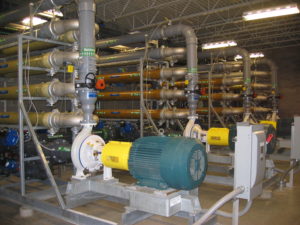
Redundant membrane skids for ease of operation and cleaning.
Simple automated cleaning operations with membranes in place
High mixed liquor concentration ensures lowest possible sludge production and requires smallest possible footprint
Simple, low maintenance system
Long-lasting tubular membranes with 0.03 μm membrane, ensuring removal of bacteria and viruses
The MBR configuration has proven to be optimal for treatment of many industrial wastewaters when treatment efficiency is an important consideration.
The MBR is the ideal bioreactor configuration for treatment of organic or inorganic contaminants present in industrial wastewater treatment systems. MBRs operate at a higher efficiency while achieving consistent design performance objectives. This makes MBR a more cost effective method of industrial wastewater treatment when performance and tank requirements are considered.
Bioreactor systems such as the conventional activated sludge system, sequencing batch reactor system and trickling filters are typically designed for operation at a lower volumetric removal rate, requiring larger tanks and more space. These conventional systems often experience upsets that inhibit settling and therefore require much more operator attention than a membrane bioreactor.
The MBR has proven to be optimal for treatment of many industrial wastewater treatment systems because it is less susceptible to upsets. The MBR’s performance is not affected by changes in sludge settleability like the conventional systems, making MBR a wise choice for industrial systems that have more difficult to treat waste streams. Dynatec Systems has over 42 years experience in dealing with difficult to treat industrial wastewaters using membrane filtration.
Contact Dynatec Systems today to discuss your wastewater solution.
https://www.dynatecsystems.com/industries/food-and-beverage/cereal/
MBR Conversion – Pharmaceutical Company
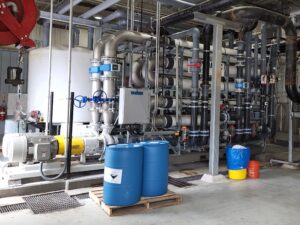 A pharmaceutical firm suffered from frequent upsets to their existing treatment process. The existing conventional aerobic biological system followed by a gravity clarifier, led to discharge noncompliance.
A pharmaceutical firm suffered from frequent upsets to their existing treatment process. The existing conventional aerobic biological system followed by a gravity clarifier, led to discharge noncompliance.
Dynatec completed bench top treatability studies and pilot studies to confirm the best method to improve performance. Adding ultrafilters as part of the conversion to a Membrane Bioreactor (MBR) was the best course of action.
MBR Conversion – Pharmaceutical Company
The wastewater stream was high in organic content (BOD, COD), and suspended solids (TSS). The MBR conversion, using a Dynatec ultrafiltration system allowed the customer to run the biological system at high mixed liquor concentrations without concern for settling characteristics. The higher mixed liquor concentration and longer sludge age proved to be successful in consistently reducing BOD and COD into compliance.
The system was designed to treat nearly 300,000 gallons per day. The COD was consistently reduced to 300 – 500 mg/l from 14,000 mg/l while BOD was reduced to non-detect.
The upgraded system handled variable loads in terms of organic load and flow rates. It consistently delivered high-quality effluent with less operator attention than their previous system. Additionally, the customer no longer faced fines for exceeding discharge limits for organics and solids.
Dynatec completed the process design, provided the equipment, and performed the installation. Existing tanks and aeration were utilized, keeping the conversion cost to less than any alternative.
Dynatec Systems industry-leading tubular ultrafiltration (UF) system can be used to treat a broad range of industrial wastewater by separating insoluble components from waste streams. As a cost effective and simple solution for separating insoluble components and colloidal contaminants from a waste stream. Wastewater ultrafiltration offers significant advantages over conventional separation. It is a useful process that does not require chemicals or much space to separate insoluble contaminants.
Contact Dynatec to discuss your wastewater treatment needs.
SBR to MBR Conversion
SBR to MBR Conversion
Dynatec provided tubular ultrafiltration systems as part of an SBR to MBR conversion. The upgraded treatment system allowed the facility to meet all discharge requirements and increased the capacity of the plant. The SBR could treat 4,000 barrels per day and the upgraded plant utilizing an out-of-basin MBR treats up to 10,000 barrels of wastewater per day.
To meet direct discharge limits, the oil refinery needed to upgrade their treatment system. The existing SBR could not handle the volume of wastewater and was not consistently meeting the discharge quality limits.
The MBR reduced the COD to below 50ppm and phenols are reduced from over 750ppm to non-detect.
The solution for this plant was an oil water separator followed by out-of-basin membrane bioreactor (MBR). The permeate from the MBR met all requirements for discharging to sea water. COD in the permeate was less than 300ppm. Phenols in the permeate were consistently less than 1ppm.
Dynatec provided containerized systems for easy and fast installation at site.
Significant Savings
- Simple process
- Fewer chemicals needed
- Low maintenance
Technology Benefits
- Consistent high-quality water
- Low operating costs
- Minimal operator intervention required
- Reduced sludge disposal costs
Contaminants Removed
- Oil and grease
- Heavy metals
- COD
- BOD
- Suspended solids
- Phenols
Flexible Retrofits
Since the membranes were installed outside the reactor, the membranes allowed for easy retrofit to any bioreactor configuration (circular, rectangular, above or below ground), . Frequently, the existing infrastructure and building space can be reused with little or no changes.
Expandability
The membrane system is easy to expand, since the out of basin configuration allows for simple addition of more membranes, or membrane skids.
Better Performance
The MBR System eliminates many of the unit processes associated with conventional treatment systems. The bioreactor tanks degrade constituents normally considered recalcitrant and they eliminate solids carry-over from occurring, allowing long sludge retention times.
Contact Dynatec to discuss your application.
